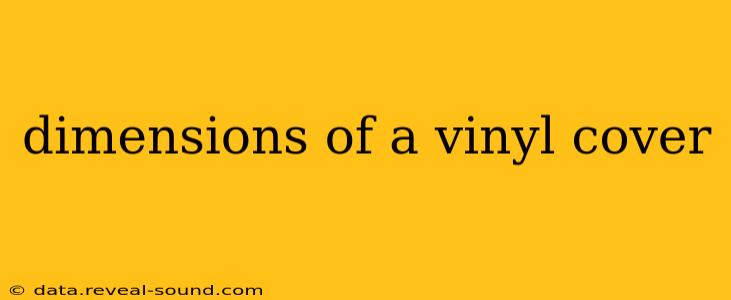The dimensions of a vinyl record cover aren't standardized across all formats, but there are some common sizes you'll encounter. Understanding these dimensions is crucial for artists, designers, and anyone working with vinyl records, whether it's for creating new artwork or preserving existing collections. This guide will delve into the typical dimensions, variations, and factors influencing the size of a vinyl cover.
What are the standard dimensions of a vinyl record cover?
The most common size for vinyl record covers is 12 inches (30.5 cm) square. This corresponds to the 12-inch LP (long-playing) record, the most prevalent format throughout vinyl's history. However, it's important to note that this is the outer dimension of the sleeve. The actual printable area will be slightly smaller to account for the spine and potential bleed.
What about 7-inch vinyl covers?
7-inch vinyl records, often used for singles, have proportionally smaller covers. These typically measure approximately 7 inches (17.8 cm) square. Again, the printable area is smaller than the overall cover size.
Are there variations in vinyl cover dimensions?
While the square format is dominant, some variations exist:
-
Gatefold Covers: These double-sized covers unfold to reveal additional artwork inside, effectively doubling the area for design and information. The closed dimensions remain consistent with the standard 12-inch or 7-inch square, but the open dimensions significantly increase.
-
Tri-fold Covers: Similar to gatefold covers, but with three panels that fold out to reveal even more artwork.
-
Special Editions: Some limited edition or promotional vinyl releases may feature non-standard cover shapes and sizes. These are less common but are a consideration for collectors.
What are the printable dimensions of a vinyl cover?
To ensure your artwork is properly displayed, you need to consider the printable area, which is always smaller than the overall cover dimensions. This "safe area" accounts for cuts and potential bleed (where the artwork extends slightly beyond the final cut line). It's essential to check with your printing service for precise safe area guidelines, as they can vary. Generally, you should expect a margin of roughly ⅛ to ¼ inch around the edges.
How do I determine the correct dimensions for my vinyl cover design?
The best approach is to consult your printing service directly. They will provide precise specifications, including bleed areas, safe areas, and acceptable file formats. This ensures your design is printed correctly and avoids cropping issues. Ignoring these specifications can result in critical design elements being lost in the final product.
What are the different types of vinyl records?
Understanding the different types of vinyl records helps clarify why dimensions might vary slightly. We've already discussed 7" and 12" LPs, but there are other formats:
- 10" Records: Less common than 7" and 12", these have their own unique cover dimensions that are proportionally between the two more common sizes.
- Picture Discs: These have covers that often match the unique designs featured on the disc itself. Dimensions can vary greatly.
This detailed exploration of vinyl cover dimensions should provide a comprehensive understanding for anyone working with this unique and enduring format. Remember, always consult with your printing partner for accurate and up-to-date specifications to guarantee a successful project.
